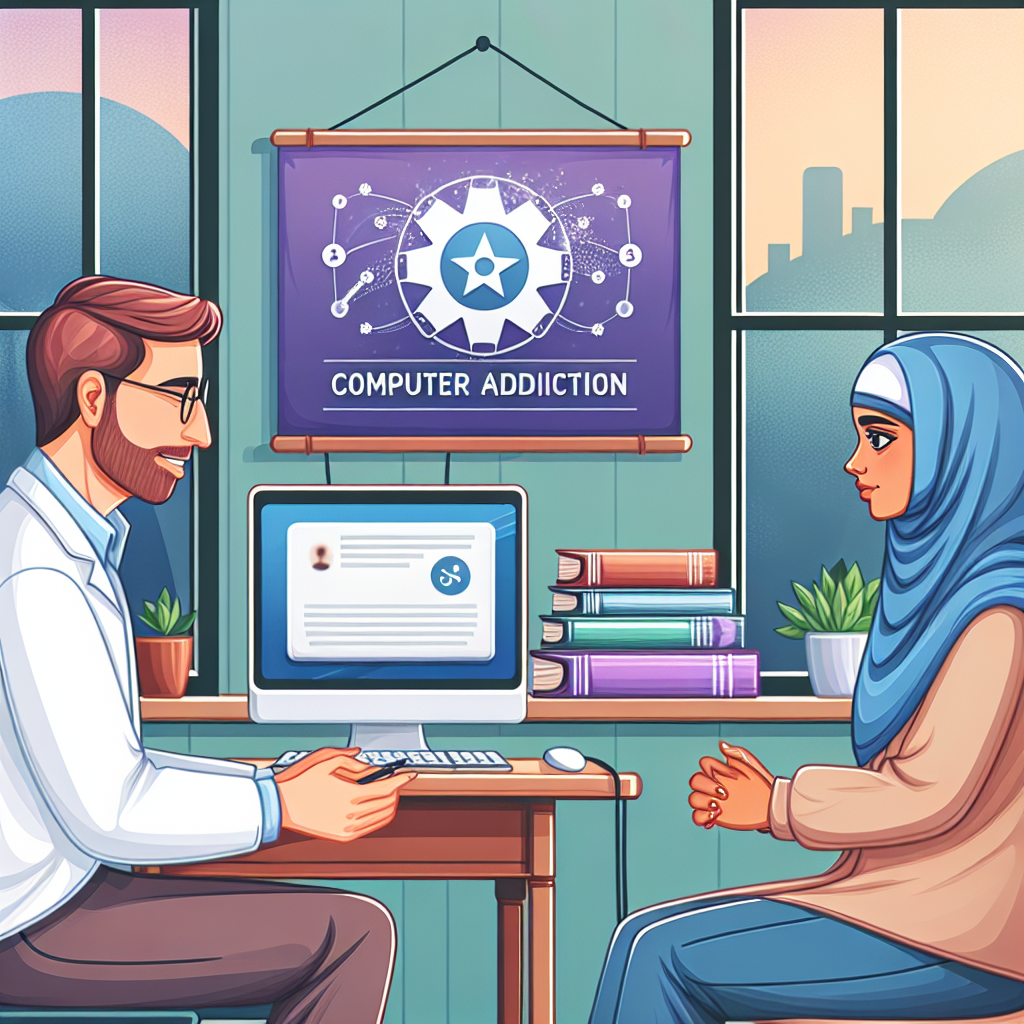-
Table of Contents

“Outpatient Treatment: Empowering Recovery from Computer Addiction, One Step at a Time.”
Introduction
Outpatient treatment for computer addiction has emerged as a viable and effective option for individuals struggling with excessive and compulsive use of digital devices. This form of treatment allows patients to receive professional help while maintaining their daily routines and responsibilities, making it a flexible and accessible choice. Research indicates that outpatient programs, which often include cognitive-behavioral therapy (CBT), individual counseling, group therapy, and family support, can significantly reduce symptoms of computer addiction. These programs aim to address the underlying psychological issues, develop healthier coping mechanisms, and promote balanced technology use. The effectiveness of outpatient treatment is further enhanced by the integration of personalized treatment plans, continuous monitoring, and the involvement of multidisciplinary teams. Overall, outpatient treatment offers a promising approach to managing computer addiction, helping individuals regain control over their digital habits and improve their overall well-being.
Evaluating Success Rates: How Effective Is Outpatient Treatment for Computer Addiction?
Outpatient treatment for computer addiction has emerged as a promising approach to addressing the growing concern of excessive computer use, which can lead to significant disruptions in daily life. As technology continues to evolve and integrate into every aspect of our lives, the need for effective treatment options becomes increasingly critical. Evaluating the success rates of outpatient treatment for computer addiction involves examining various factors, including the methodologies employed, the commitment of the individuals undergoing treatment, and the support systems in place.
One of the primary advantages of outpatient treatment is its flexibility. Unlike inpatient programs, which require individuals to stay at a treatment facility, outpatient programs allow participants to maintain their daily routines while receiving the necessary support and guidance. This flexibility can be particularly beneficial for those who have work, school, or family commitments that they cannot abandon. By integrating treatment into their everyday lives, individuals can apply the strategies they learn in real-time, which can enhance the overall effectiveness of the program.
Moreover, outpatient treatment often includes a combination of individual therapy, group therapy, and educational sessions. Individual therapy provides a personalized approach, allowing therapists to tailor their strategies to the specific needs and challenges of each person. This one-on-one interaction can help individuals identify the underlying causes of their addiction, develop coping mechanisms, and set realistic goals for reducing their computer use. Group therapy, on the other hand, offers a sense of community and shared experience. Participants can connect with others who are facing similar struggles, which can foster a sense of belonging and reduce feelings of isolation. Educational sessions provide valuable information about the impact of computer addiction on mental and physical health, as well as practical tips for managing screen time.
The success of outpatient treatment also heavily relies on the commitment and motivation of the individuals involved. Those who are genuinely willing to make changes and actively participate in their treatment are more likely to see positive outcomes. It is essential for participants to set realistic goals and be patient with themselves throughout the process. Change does not happen overnight, and setbacks are a natural part of recovery. However, with perseverance and a strong support system, individuals can make significant progress.
Support systems play a crucial role in the effectiveness of outpatient treatment. Family members, friends, and even employers can provide encouragement and accountability, which can help individuals stay on track. Additionally, many outpatient programs offer follow-up sessions and ongoing support to ensure that participants continue to make progress even after the initial treatment period has ended. This continuous support can be instrumental in preventing relapse and maintaining long-term success.
While the success rates of outpatient treatment for computer addiction can vary, many individuals have reported significant improvements in their ability to manage their computer use and lead more balanced lives. The combination of personalized therapy, community support, and practical education creates a comprehensive approach that addresses the multifaceted nature of computer addiction. By fostering a supportive environment and encouraging active participation, outpatient treatment can empower individuals to regain control over their technology use and improve their overall well-being.
In conclusion, outpatient treatment for computer addiction offers a flexible and effective solution for those struggling with excessive computer use. By integrating treatment into daily life, providing personalized and group support, and fostering a strong commitment to change, individuals can achieve meaningful and lasting improvements. With the right support and determination, overcoming computer addiction is not only possible but also a journey that can lead to a healthier and more fulfilling life.
Key Benefits and Challenges: The Effectiveness of Outpatient Treatment for Computer Addiction
Outpatient treatment for computer addiction has emerged as a promising approach to addressing the growing concern of excessive computer use. This method offers a range of benefits while also presenting certain challenges that need to be carefully managed. Understanding the effectiveness of outpatient treatment requires a comprehensive look at both its advantages and potential obstacles.
One of the key benefits of outpatient treatment is its flexibility. Unlike inpatient programs, outpatient treatment allows individuals to maintain their daily routines, including work, school, and family responsibilities. This continuity can be crucial for those who cannot afford to take extended time away from their obligations. By integrating treatment into their everyday lives, individuals can apply the coping strategies and skills they learn in real-time, which can lead to more sustainable behavioral changes.
Moreover, outpatient treatment often includes a variety of therapeutic approaches, such as cognitive-behavioral therapy (CBT), group therapy, and individual counseling. These therapies are designed to address the underlying issues that contribute to computer addiction, such as anxiety, depression, or social isolation. By targeting these root causes, outpatient programs can help individuals develop healthier relationships with technology and improve their overall mental health.
Another significant advantage of outpatient treatment is the support network it provides. Group therapy sessions, in particular, offer a sense of community and shared experience that can be incredibly motivating. Participants can learn from each other’s successes and setbacks, fostering a collaborative environment that encourages personal growth. Additionally, the involvement of family members in the treatment process can enhance the support system, making it easier for individuals to stay committed to their recovery goals.
However, outpatient treatment is not without its challenges. One of the primary obstacles is the potential for relapse. Since individuals are not in a controlled environment, they may find it difficult to resist the temptation to revert to their old habits. This risk underscores the importance of a strong support system and ongoing monitoring to ensure that individuals stay on track. Regular check-ins with therapists and participation in support groups can help mitigate this risk by providing continuous encouragement and accountability.
Another challenge is the variability in the quality of outpatient programs. Not all programs are created equal, and the effectiveness of treatment can depend heavily on the expertise of the therapists and the comprehensiveness of the program. It is essential for individuals and their families to thoroughly research and choose a program that is well-regarded and has a proven track record of success.
Despite these challenges, the potential for positive outcomes with outpatient treatment is significant. Many individuals have successfully overcome their computer addiction through these programs, reclaiming their lives and achieving a healthier balance with technology. The key to success lies in a personalized approach that addresses the unique needs of each individual, combined with a robust support system and a commitment to long-term recovery.
In conclusion, while outpatient treatment for computer addiction presents certain challenges, its benefits make it a viable and effective option for many individuals. The flexibility, variety of therapeutic approaches, and strong support networks offered by outpatient programs can lead to meaningful and lasting change. By addressing the root causes of addiction and providing continuous support, these programs can help individuals regain control over their lives and foster a healthier relationship with technology.
Q&A
1. **Question:** What are some common components of outpatient treatment for computer addiction?
**Answer:** Common components of outpatient treatment for computer addiction include cognitive-behavioral therapy (CBT), individual counseling, group therapy, and sometimes medication management for co-occurring mental health issues.
2. **Question:** How does the effectiveness of outpatient treatment for computer addiction compare to inpatient treatment?
**Answer:** Outpatient treatment can be effective for individuals with computer addiction, especially when they have a strong support system and are highly motivated. However, inpatient treatment may be more effective for severe cases or when the individual lacks a supportive home environment.
Conclusion
Outpatient treatment for computer addiction can be effective, particularly when it includes a combination of cognitive-behavioral therapy (CBT), psychoeducation, and support groups. These approaches help individuals develop healthier habits, improve time management, and address underlying psychological issues. However, the effectiveness varies depending on the individual’s commitment, the severity of the addiction, and the presence of co-occurring mental health conditions. Regular follow-ups and a strong support system are crucial for sustained recovery.



